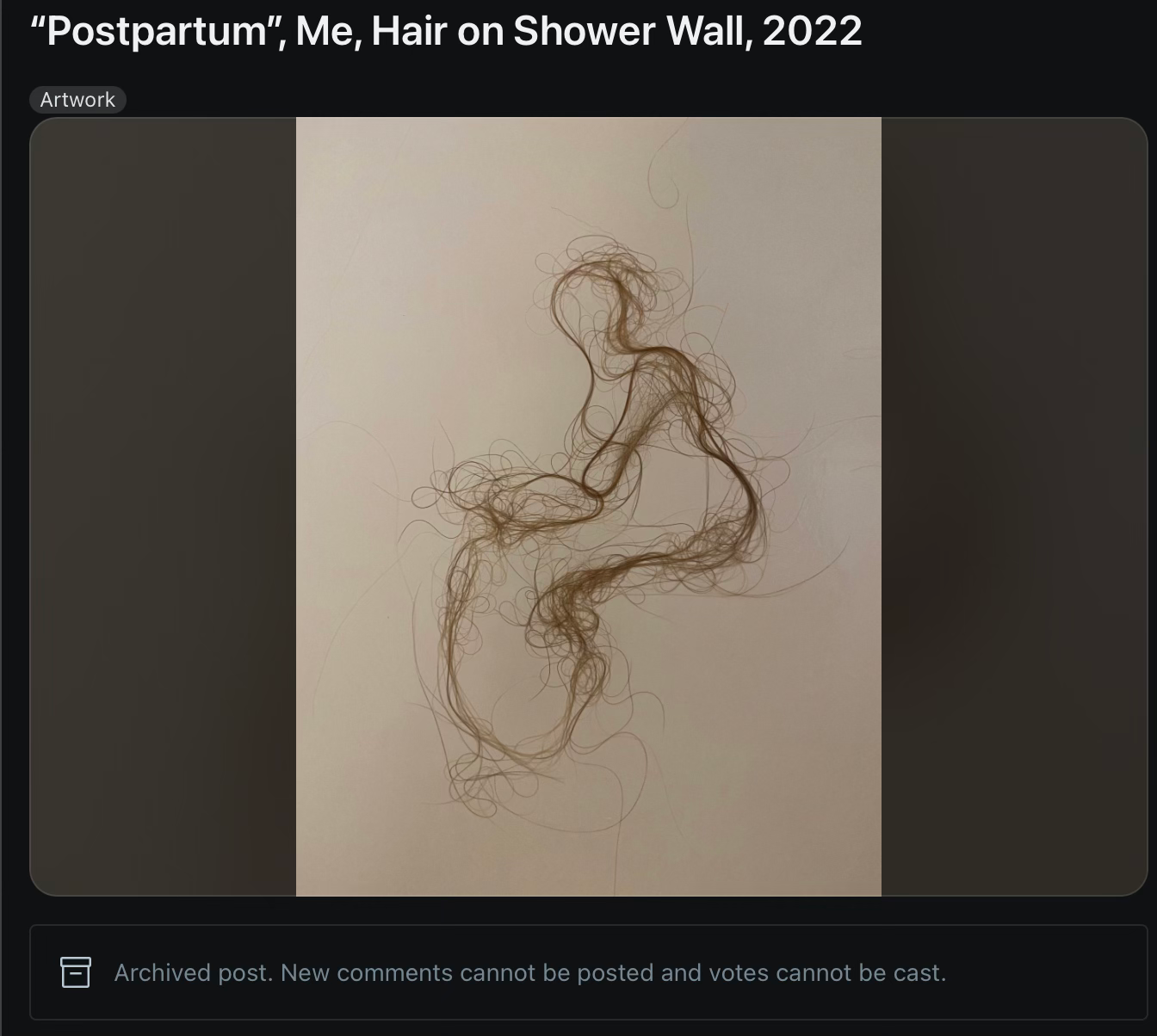Humans who have given birth lose more hair than they grow for up to five months postpartum
And some of them have made art with it
According to the Mayo Clinic, “for up to five months after giving birth, you lose more hair than you grow.”
This is just one of the many things happening to the body after birthing, and for me, it’s the one with the most potential to gross me out. I loathe finding hair anywhere, and losing more of it means a greater chance of finding it everywhere. And that’s my bathroom right now: hair on the counter, the floor, in the shower, clogging the sink drain.
Hair is routinely getting stuck in my bra and/or shirt and tickling me (just like a bug would) all day. For some people (at least on Reddit), most of the hair loss seems to take place in the shower.
A user named Shmamilla posted the artwork below, created under such circumstances. If I ignore the fact that it’s hair on a shower wall (ick factor, for me!), I really like it. It reminds me of loose pencil work, and it’s interesting to think about the lines our bodies make on their own, separate from our attempts to control.
For me, the measure of an artwork is partially in the way that people experiencing it can relate to it. From the comments, it’s obvious Shmamilla struck a chord:
It brought up tender remembrances—for those who don’t know, a “rainbow baby” is a baby born after the parent has experienced loss, either of a pregnancy or a child.
It evoked thoughts of the moments just following birth when birthing parent and babe are indeed—to put it mildly—quite a mess, and started a discussion about when hair is a good choice of medium.
Another user, “The-DonutWizard,” echoed my own reaction when they wrote: “This is both gross and beautiful at the same time.” The artist responded: “Your comment perfectly describes motherhood.” Also true.
Non-male artists have long been told not to take parenthood as their subject, when they’ve been allowed to make art at all. Maybe those delivering this edict believed such art wouldn’t resonate. Or maybe they had a sense of the power of the topic—of the experience—and didn’t want their own art to be sidelined.
Over 6,000 users upvoted Shmamilla’s post. In the last few years, thanks to writers like Hettie Judah and Katy Hessel, artists depicting themes of parenthood, care-work, loss, and family life have started to be known. They have used unique media, like Wendy War Ehlers’s employment of dryer lint (see below), and covered subjects as ubiquitous as our bodies.

One of my favorite examples of an artist chronicling body change is the work of Laxmi Hussain. Hussain’s work is joyous, most often made up of only one or two colors (almost always ultramarine blue), and full of the curves our figures make prenatally and during the long postpartum period.

Not everyone encourages art-making and body acceptance as the go-to postpartum mode. When searching online for work made by postpartum artists, much of the top results have nothing to do with art. Instead, they reveal a plethora of businesses making money off the idea that the postpartum body is one in need of “fixing,” offering services targeted at hair loss, “excess” skin, hormonal imbalance (maybe legitimate if your care provider brings it up), cellulite, and more.
Birthing people are encouraged by our consumerist and appearance-focused societies to get back to their pre-birth selves as soon as possible after delivery. Plastic surgeons advertise a package of services called a “mommy makeover,” including a breast lift, tummy tuck and buttock augmentation. This website says “a mommy makeover can restore the figure you had before the changes caused by pregnancy.”
It’s understandable that people want this set of procedures or feel their bodies are inadequate in some way after birth. The messaging is everywhere that if we aren’t as thin, mark-free, youthful looking, etc., we have lost some of our value. Even with a vastly different mindset than I had during my teens and twenties, these feelings have definitely cropped up now and then for me.
What I learned during recovery from an eating disorder about a decade ago was that the feelings and messaging don’t stop. It’s the way you play interference that counts. What messages do you listen to, and what do you say back? Not in a corny way, but really, how do you answer your own questions or doubts about yourself? What is your actual (probably repeated) thought or spoken or written response?
I bring up these search results because they are very effective at distracting away from the power of what any person has accomplished who has birthed, attended to the needs of a small baby, or otherwise cared for someone at the expense of their own body. A power that might be channeled into deeper relationships, art-making, or just a more settled sense of one’s place in the world.
Have you used your body, or something in your surroundings while postpartum, to make art? Do you know someone who has? What do you think of these pieces, included here?
—Sarah
If you enjoyed this newsletter, please subscribe and/or share it. I’d like to reach more people in and beyond this phase of life.





